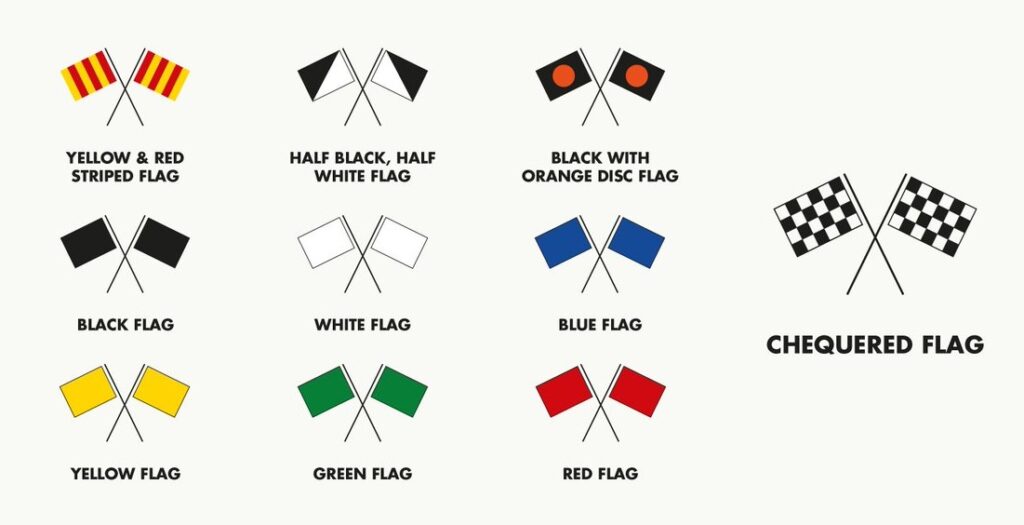F1 Track Flags Explained

During an F1 weekend there are usually a lot of flags displayed on track. Not team flags or flags representing different nationalities, but flags from race control used to instruct drivers and let them know about certain track conditions. There are basically ten flags and two types of safety cars, virtual and the real deal. Let’s take a look…
GREEN – Shown at the start of a session and after an incident. It means normal racing conditions apply and the track is clear.
YELLOW – Indicates a hazard partially on or near the track. Drivers must reduce speed, not overtake and be prepared to change direction. TWO YELLOW FLAGS indicates a hazard wholly or partly blocking the track and/or marshals working on or beside the track. Drivers are instructed to reduce speed significantly, not overtake, and be prepared to change direction or stop.
YELLOW AND RED – This flag is striped and indicates a change in the track surface ahead, meaning that traction is reduced due to oil, water or loose debris. The flag is held stationary but may be rocked (not waved) side to side to indicate a small animal on track.
BLACK AND ORANGE – This flag has a black background with an orange circle in the middle. Indicates to the driver that their car is damaged and that they must return to pit lane on the next lap in order to address the issue. The flag will be accompanied by the car number for identification.
BLACK AND WHITE – The two colors are separated by a diagonal line. Held stationary with the driver’s number to indicate a warning for unsportsmanlike conduct or dangerous behavior. If a driver does not change their conduct then a time penalty or black flag may follow. Typically seen for overstepping track limits.
BLACK – Driver is disqualified and must return to pit lane. Accompanied by driver’s number.
BLUE – Indicates to a driver that they are being lapped by a faster car behind. The driver being lapped must let the faster car through at the earliest opportunity. If three blue flags are missed in succession the driver may be penalized. A stationary blue flag will be shown to a driver leaving pit lane when another car is approaching on track.
WHITE – Indicates a slow-moving vehicle is ahead, such as a service vehicle or the medical car. Also used at the end of a practice session when drivers like to practice starts on the grid.
RED – Signals that the session or race has been suspended due to unsafe track conditions. Drivers must significantly reduce speed and return to pit lane.
CHECKERED – Everybody knows this one. Used to signal the end of practice, qualifying or the race. If you’re a driver the trick is to be the first one to see this flag.
Drivers have flag indicators on their steering wheel display. Also there are electronic flag displays in areas where there are no marshals. As for Safety Cars, they are typically deployed when the situation on track has become too dangerous for the racing to continue but a red flag is not warranted. Under a Safety Car, speeds are greatly reduced and cars will bunch up single file. Overtaking is not allowed although pit stops are. Also, lapped cars may be allowed to unlap themselves and rejoin in the rear of the field. Once the Safety Car returns to pit lane the lead car controls the pace until it crosses the timing line, at which point the race resumes. A Virtual Safety Car, often referred to as VSC forces drivers to reduce speed by approximately 30% and follow a timing delta to maintain gaps between cars rather than bunching up as they would under a Safety Car. Another advantage to the VSC is that cars can be slowed immediately without waiting for the Safety Car to come out.